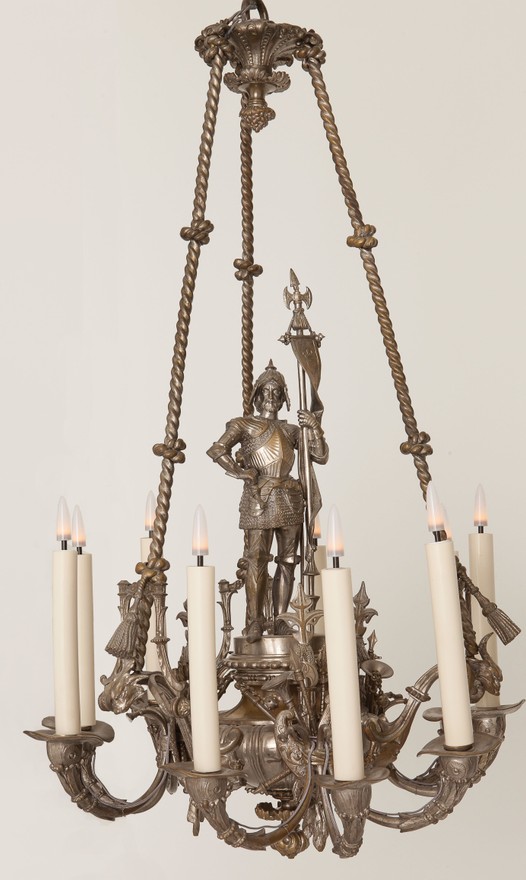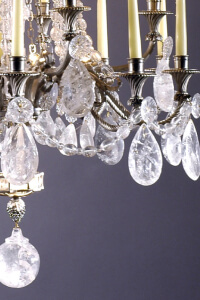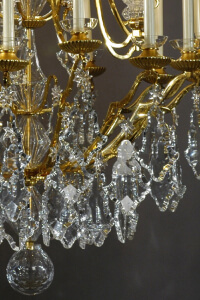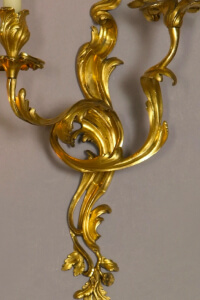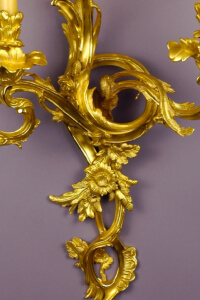Chandelier decorated with a Knigh, from Jean-François-Théodore Gechter, with nine arms of light with chivalrous weapons and trophies, around a knight in armor holding a banner of war.
Born in Paris in 1796, Gechter first attended the Ecole des Beaux-Arts where he was taught by François Joseph Bosio, sculptor, and the painter Antoine Jean Gros. A fellow student of Barye in these workshops, he specialized in sculpture around 1820 and exhibited at the Salon from 1824 to 1840. His first public commission was to cast the group of Charles Martel, the plaster of which was presented at the 1833 Salon.
The rediscovery of medieval culture in the 19th century borrowed from history, creating of a style we have characterized as "Troubadour". Initially from the literature of Sr. Walter Scott, then from painting by François Fleury-Richard and Pierre Revoil, this intellectual movement quickly establish itself in the decorative arts. This chandelier with "the knight in armor" perfectly illustrates the desire for historical rediscovery in the arts which corresponds to the royalist and nationalist movement of the Duchesse de Berry. Mounted with trophies, weapons, ceremonial mace, halberds, shields, clubs, torches and trumpets, the knight in armor is very close to the naturalistic style of works by Frémiet. This chandelier is similar to his famous Jeanne d’Arc and Saint Michel terrassant le dragon.
The troubadour style, inspired by the Middle Ages and the Renaissance, emerged during the Restoration in the first half of the 19th century and almost seemed to be a reaction to the Empire style.
It also symbolizes a re-discovery of medieval imagery, after the breakdown of the Revolution.
The influence of the English Gothic Revival style, which appeared in the last third of the 18th century, is however just as obvious, which leads scholars to see in troubadour imagery one of the components of Romanticism.
Lustre au Chevalier de Jean-François-Théodore Gechter, à neuf bras de lumière sur des trophées d’armes chevaleresques, encadrant un chevalier en armure portant une oriflamme.
Né à Paris en 1796, Gechter suit tout d’abord les cours de l'Ecole des Beaux-Arts où il a pour maîtres François Joseph Bosio, sculpteur, et le peintre Antoine Jean Gros. Condisciple de Barye dans ces ateliers, il se spécialise en sculpture vers 1820 et expose au Salon de 1824 à 1840. Sa première commande publique est celle de la fonte du groupe de Charles Martel dont le plâtre avait été présenté au Salon de 1833.
La redécouverte de la culture médiévale au XIXe siècle va générer la création d’un style emprunt d’historicisme que l’on qualifiera d’esprit «Troubadour». Initié par la littérature avec Walter Scott, puis la peinture, avec François Fleury-Richard ou Pierre Revoil ce courant intellectuel va rapidement s’imposer dans les arts décoratifs. Ce lustre « au chevalier en armure » illustre parfaitement cette volonté de réappropriation historique dans les arts qui correspond au mouvement royaliste et nationaliste de la duchesse de Berry. Surplombant des trophées avec masses d’armes, hallebardes, boucliers, massues, torches et trompettes, le chevalier en armure est très proche du naturalisme impulsé par les œuvres de Frémiet. Ce lustre est à rapprocher de la célèbre Jeanne d’Arc et Saint Michel terrassant le dragon.
Le style troubadour, inspiré du Moyen-Age et de la Renaissance, émerge à la Restauration dans la première moitié du XIXe siècle et semble presque être une réaction au style Empire.
Il symbolise aussi une re-découverte de l’imagerie médiévale, après la rupture de la Révolution.
L'influence du style néo-gothique anglais, apparu dans le dernier tiers du XVIIIe siècle, est cependant tout aussi manifeste, ce qui conduit les spécialistes à voir dans l'imagerie troubadour l'une des composantes du romantisme.






